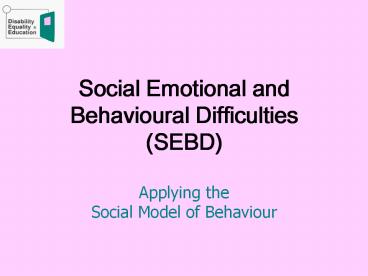Social Emotional and Behavioural Difficulties (SEBD) PowerPoint PPT Presentation
Title: Social Emotional and Behavioural Difficulties (SEBD)
1
Social Emotional and Behavioural Difficulties
(SEBD)
- Applying the Social Model
of Behaviour
2
What does Society want from Education?
- Education is societys way of instilling
socially acceptable behaviour and preparing
people for the labour market.
Education leads to employment
Employment leads to social inclusion
3
Education develops intellectual and
social skills
- Easy to measure the development of intellectual
skills. - BUT
- Pressure to do this, works against the
development of social skills. - A school that works intensively with one child so
he can bear to sit down for seven minutes
receives very little credit, compared to a school
that has students with top marks in their exams.
4
School Exclusions
There were 9,290 permanent exclusions from
primary, secondary and all special schools in
2002/3. 83 from secondary schools 14 from
primary school 3 from special schools
- There were also many informal exclusions, e.g.
internal exclusions, arrangements between parents
and head-teachers who come to an accommodation
about the child not coming in to school.
5
97/8 98/9 99/00
00/01 01/02 02/03
6
Who gets Excluded?
- Children who are poor or have other forms of
disadvantage (e.g. family trauma) are massively
over-represented.
Children with Special Needs
0.45 of all SEN pupils excluded, compared to
0.05 with no SEN
Children with a diagnosis of, or perceived as
having, Social, Emotional Behavioural
Difficulties.
Boys are excluded at a rate of 4x as many as
girls in 2002/3 82 were boys
7
What do we mean by Social, Emotional and
Behavioural Difficulties?
- No agreed definitions.
- What I consider to be Social Emotional
Behavioural Difficulties might not be what you
call Social Emotional Behavioural Difficulties
(SEBD).
8
What do teachers mean when they say a child has
SEBD?
This childs behaviour is strange and disturbing?
This childs behaviour is extremely difficult to
cope with?
- We think this child has more severe problems than
most?
Someone more expert than us should solve this
problem?
Children with physical impairments rarely get
labelled SEBD, even if their behaviour is
appalling.
9
What happens when we label children with SEBD?
- The more we label children as having Social,
Emotional and Behavioural Difficulties and
therefore different, the more we believe that
ordinary teachers cant cope with them. - We believe these children must have specialist
treatment, therapy, etc. The Medical model is
applied.
10
Medical Model of Behaviour
- Child is removed to special environment who can
deal with the problems. - Education is put on hold,
- Attention is put on the behaviour and managing
it. - Skills are under-developed
- Employment opportunities diminish,
- Social exclusion ensues (and often continues
throughout life, e.g. criminalisation,
imprisonment, etc.) - Cost to the child, his peers and family, and to
society is inestimable
11
The Social Model of Behaviour
- A whole school, whole person approach recognises
- the capacities and strengths of every child
- that everyone has issues behavioural
difficulties are part of a continuum - that social and organisational issues contribute
to behaviour management - that developing a normalised approach towards
behaviour management empowers everyone - that everyone in the school (including the staff)
need to learn and practice social and emotional
skills
12
The Social Model of Behaviour
- Recognises
- That all feelings are important.
- This means difficult, challenging emotions, as
well as happy, pleasant ones. - That everyone can develop emotional literacy - it
is a continuum - That teachers need support to think well about
every child no one can do it alone. - That children are able to think well about each
other (sometimes in places where adults are not)
13
Turning Lead into Gold Similar behaviours can be
described positively or negatively
- Learning disabled
- Learning different
- Hyperactive
- Energetic
- Dyslexic
- A spatial learner.
- Aggressive
- Assertive
- Plodding
- Thorough
- Lazy
- Relaxed
14
Turning Lead into Gold Similar behaviour can be
described positively or negatively
- Phobic
- Cautious
- Immature
- In touch with an inner child
- Scatty
- A plate spinner
- Dreamy
- Imaginative
- Irritable
- Sensitive
- Obsessive
- Persistent
Adapted from All My Lifes a Circle, Thomas
Armstrong, Inclusion Press (Toronto)
15
The World I Want to Live In Amanda Baggs
- I want to live in a world where it is okay, even
admirable, to be autistic. I want to live in a
world where autism is known to be the unique and
beautiful thing that it is. I want to live in a
world where I can be sure that autistics will be
loved and respected as who we are, not drugged or
forced to behave as something we are not. I want
to live in a world where I can say, "I am
autistic" and not be expected to be a bundle of
abnormalities and deficits. I want the word
"Autism" to an image of a wonderful and unique
person with a wonderful and unique way of being
and experiencing the world. I want to live in a
world where autistics are celebrated, not
degraded.

